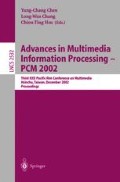Abstract
The MPEG-2 AAC standard uses both long and short windows. However, the use of short windows complicates the implementation of decoders as well as encoders. In this paper, we propose a method based on the modification of the amplitude of the time-domain signal to replace the function of short windows. Compared with the use of short windows, the proposed approach is relatively easy to implement. The subjective experiments show that the proposed approach is a promising alternative in coding transient signals.
Access this chapter
Tax calculation will be finalised at checkout
Purchases are for personal use only
Preview
Unable to display preview. Download preview PDF.
References
ISO/IEC: Information Technology-Coding of Moving Pictures and Associated Audio for Digital Storage Media at up to About 1.5 Mbit/s-Part 3: Audio. IS 11172–3 (1993).
ISO/IEC: Information Technology-Generic Coding of Moving Pictures and Associated Audio Information-Part 3: Audio. 2nd edn. IS 13818–3 (1998).
ISO/IEC: Information Technology-Generic Coding of Moving Pictures and Associated Audio Information-Part 7: Advanced Audio Coding (AAC). IS 13818–7 (1997).
Advanced Television Systems Committee: Digital Audio Compression Standard (AC-3). Doc. A/52, (1995).
Bosi M., et al: ISO/IEC MPEG-2 Advanced Audio Coding. Journal of Audio Eng. Soc. 45 (1997) 789–812.
ISO/IEC: Information Technology-Coding of Audio-visual Objects-Part 3: Audio, Subpart 4 General Audio Coding. IS 14496–3 (1999).
Herre J., Johnston J. D.: Enhancing the Performance of Perceptual Audio Coders by Using Temporal Noise Shaping (TNS). 101st Conference of the Audio Engineering Society, Los Angeles, CA (1996) pre-print 4384.
Author information
Authors and Affiliations
Editor information
Editors and Affiliations
Rights and permissions
Copyright information
© 2002 Springer-Verlag Berlin Heidelberg
About this paper
Cite this paper
Yu, CH., You, S.D. (2002). On the Possibility of Only Using Long Windows in MPEG-2 AAC Coding. In: Chen, YC., Chang, LW., Hsu, CT. (eds) Advances in Multimedia Information Processing — PCM 2002. PCM 2002. Lecture Notes in Computer Science, vol 2532. Springer, Berlin, Heidelberg. https://doi.org/10.1007/3-540-36228-2_82
Download citation
DOI: https://doi.org/10.1007/3-540-36228-2_82
Published:
Publisher Name: Springer, Berlin, Heidelberg
Print ISBN: 978-3-540-00262-8
Online ISBN: 978-3-540-36228-9
eBook Packages: Springer Book Archive

